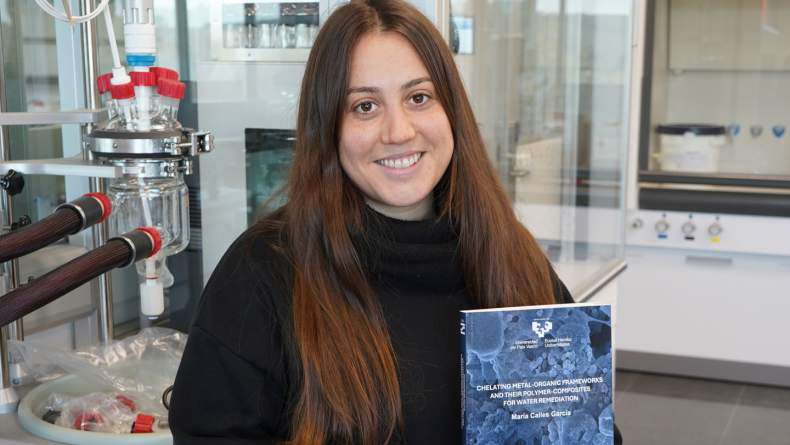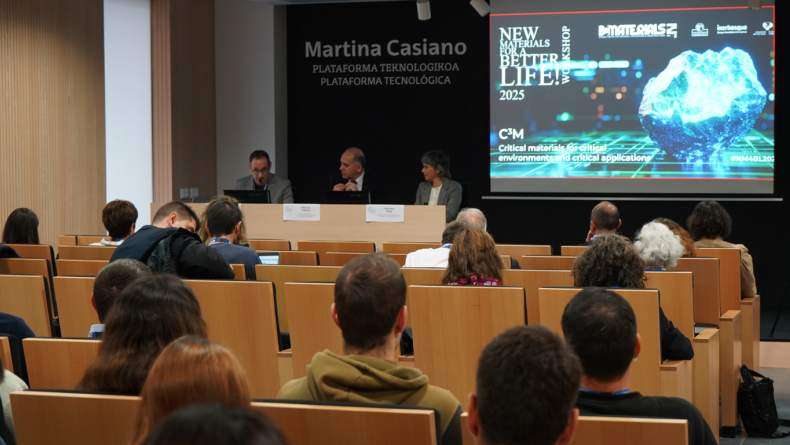BCMaterials Fortnightly Seminar #88 Irati Rodrigo - Roberto Fernández

IRATI RODRIGO
(BCMATERIALS)
Characterization of the electromagnetic applicator for magnetic hyperthermia experiments.
Magnetic hyperthermia is a cancer therapy, where magnetic nanoparticles (MNP) placed inside the tumour act as heat sources activated by an externally applied magnetic field. These nanoparticles increase the temperature of the tumour cells causing the destruction of the tumour. One of the most important parameters of MNP used in magnetic hyperthermia is their specific absorption rate (SAR), which is the absorbed energy per unit of nanoparticle mass. Our group has developed an accurate AC magnetometer, which allow the quantification of SAR. This magnetometer calculates the SAR measuring the dynamic magnetization with two pick up coils. SAR is obtained from the integral of the dynamic magnetization vs the applied magnetic field (generated by an inductor). This AC magnetometer works in a wide frequency range of AC magnetic field (149–1030 kHz) and with large field intensity: up to 35 kA m−1 at low frequencies and up to 22 kA m−1 at high frequencies (above 1 MHz). The main aim of this these is to design and built a new AC magnetometer that will work in higher field intensities and add a temperature controller of the sample. This will allow us to measures SAR in different temperature, which is very important to study new non invasive thermometry methods in order to measure the temperature of the tissue during the treatment. Previously, it has been shown the design and implementation of the main inductor (which generates the magnetic field necessary for the hyperthermia) and the resonant circuit (which allow us to work in a frequency range). During this talk, it will be shown the characterisation of the main inductor and the resonant circuit, from the impedance to the experimental magnetic field.
ROBERTO FERNÁNDEZ
(BCMATERIALS)
Thermal activation of charge carriers in ionic and electronic semiconductor β-AgIVVO3 and β-AgIVVO3@VV1.6VIV0.4O4.8 composite xerogels.
Thermal dependence of electric properties for pure β-AgIVVO3 and composite β-AgIVVO3@VV1.6VIV0.4O4.8 xerogels were studied by means of impedance spectroscopy. β-AgIVVO3 xerogels show a complex electronic response with temperature, showing a protonic conduction near room temperature, and an ionic conduction at high temperatures. In fact, hydroxyl or water molecules covalently bonded to the silver vanadium oxide nanoribbons surface play a crucial role as ion charge carriers, since their removal above 300ºC, suppress the ionic conduction in the β-AgIVVO3 xerogels. For the composite xerogels, an electric conduction behavior is observed, with a thermal charge carrier activation during the heating cycles. We are currently studying the impact of the covalently bonded hydroxyl or water molecules, as well as the vanadium mixed valence in the electric properties of composite hydrogels, but preliminary studies suggest that both play a crucial role as electron carriers.Related news
María Calles, BCMaterialseko doktore berria
María Calles García zoriondu nahi dugu UPV/EHUn Materialen Zientzia eta Teknologian doktoretza lortzeagatik. Abenduaren 4an Maríak ‘Chelating Metal-Organic Frameworks and Their Polymer-Composites…Bartzelonako Mikroelektronika Institutuko ikertzaileekin hitzaldi gonbidatua (abenduak 3)
Datorren abenduaren 3an, 12:00etatik aurrera Leioako Martina Casiano auditorioan, BCMaterialsek Bartzelonako Mikroelektronika Institutuko (IMB-CNM) (CSIC) Antón Guimerà eta Xavier Illa ikertzaile…Hitzaldi gonbidatua Liu Yaorekin metal-litiozko bateriei buruz (abenduak 2)
Datorren astelehenean, abenduaren 2an, Liu Yao Shanghai Institute of Applied Physics-eko irakasleak "Li Metal Batteries: From Liquid to Solid-State" hitzaldia aurkeztuko du BCMaterials-en. Hitzaldia…BCMaterials-en urteko workshoparen arrakasta, material kritikoei eskainia
BCMaterialsen urteko workshoparen 2025. edizio arrakastatsuak ehun bat lagun bildu zituen azaroaren 19an Leioan, artearen egoera aztertzeko eta material kritikoei, materialen aplikazio kritikoei eta…



